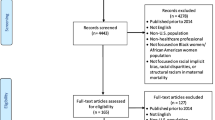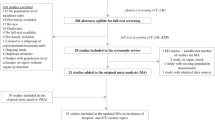Abstract
Severe maternal morbidity (SMM) is 50 to 100 times more common than maternal death, and has increased disproportionately among ethnic/racial minority women in the United States. However, specific knowledge about how the types and timing of severe maternal morbidities deferentially affect ethnic/racial minority women is poorly understood. This study examines racial/ethnic disparities in severe maternal morbidity during antepartum (AP), intrapartum (IP), and postpartum (PP) hospital admissions in the United States (US) for 2002–2014. We identified AP, IP, and PP hospitalizations in the National Inpatient Sample. Distribution of sociodemographic, behavioral and hospital characteristics, insurance, comorbidities, and SMM occurrence was summarized using descriptive statistics. Through Joinpoint regression, temporal SMM trends of hospitalizations were examined and stratified by race. Multivariate logistic regression assessed the association between race and SMM. We found black women have the highest proportion of SMM across all pregnancy intervals with a 70% greater risk of SMM during AP after adjusting for all cofactors. In the PP period, Hispanic women’s risk of SMM is 19% less when compared to white women. Racial/ethnic disparities in SMM vary in timing and SMM type. Systematic investigation is needed to understand risks to black women and the protective factors associated with Hispanic women in the PP. Addressing racial disparities in maternal morbidity and mortality requires national policies and initiatives tailored to black women that address the specific types and timings of life-threatening obstetric complications.


Similar content being viewed by others
References
Lewis G. Beyond the numbers: reviewing maternal deaths and complications to make pregnancy safer. Br Med Bull. 2003;67(1):27–37. https://doi.org/10.1093/bmb/ldg009.
Cecatti CJG, Souza JP, Cecatti JG, Parpinelli MA, Helena De Sousa M, Serruya SJ. Systematic review of near miss maternal morbidity. Int J Gynaecol Obstet. 2006;22(2):255–64.
Geller SE, Rosenberg D, Cox SM, Brown ML, Simonson L, Driscoll CA, et al. The continuum of maternal morbidity and mortality: factors associated with severity. Am J Obstet Gynecol. 2004;191(3):939–44. https://doi.org/10.1016/j.ajog.2004.05.099.
Creanga AA, Bateman BT, Kuklina EV, Callaghan WM. Racial and ethnic disparities in severe maternal morbidity: a multistate analysis, 2008–2010. Am J Obstet Gynecol. 2014;210(5):435.e1–8. https://doi.org/10.1016/j.ajog.2013.11.039.
Creanga AA, Berg CJ, Ko JY, Farr SL, Tong VT, Bruce FC, et al. Maternal mortality and morbidity in the United States: where are we now? J Women's Health (Larchmt). 2014;23(1):3–9. https://doi.org/10.1089/jwh.2013.4617.
Kilpatrick SK, Ecker JL, Ecker JL. Severe maternal morbidity: screening and review. Am J Obstet Gynecol. 2016;215(3):B17–22. https://doi.org/10.1016/j.ajog.2016.07.050.
CDC. Severe maternal morbidity in the United States | Pregnancy | Reproductive Health |CDC. https://www.cdc.gov/reproductivehealth/maternalinfanthealth/severematernalmorbidity.html#anchor_References. Accessed June 13, 2017.
Brown HL, Chireau MV, Jallah Y, Howard D. The “Hispanic paradox”: an investigation of racial disparity in pregnancy outcomes at a tertiary care medical center. Am J Obstet Gynecol. 2007;197(2):197.e1–9. https://doi.org/10.1016/j.ajog.2007.04.036.
Center for Disease Control and Prevention. Severe maternal morbidity indicators and corresponding ICD Codes during delivery hospitalizations. https://www.cdc.gov/reproductivehealth/maternalinfanthealth/smm/severe-morbidity-ICD.htm. Published 2018. Accessed January 14, 2019.
Lawton B, MacDonald E, Brown S, Wilson L. Preventability of severe acute maternal morbidity. Am J Obstet Gynecol. 2014. http://www.sciencedirect.com/science/article/pii/S0002937813022436. Accessed February 8, 2017.
Lawrence JM, Contreras R, Chen W, Sacks DA. Trends in the prevalence of preexisting diabetes and gestational diabetes mellitus among a racially/ethnically diverse population of pregnant women, 1999–2005. Diabetes Care. 2008;31(5) http://care.diabetesjournals.org/content/31/5/899.long. Accessed August 24, 2017.
Hinkle SN, Sharma AJ, Kim SY, Park S, Dalenius K, Brindley PL, et al. Prepregnancy obesity trends among low-income women, United States, 1999–2008. Matern Child Health J. 2012;16(7):1339–48. https://doi.org/10.1007/s10995-011-0898-2.
Martin JA, Brady MPH, Hamilton E, et al. National vital statistics reports Vol 62, No. 1 June 28, 2013. 2011. http://www.cdc.gov/nchs/VitalStats.htm. Accessed January 9, 2019.
Fisher SC, Kim SY, Sharma AJ, Rochat R, Morrow B. Is obesity still increasing among pregnant women? Prepregnancy obesity trends in 20 states, 2003–2009. Prev Med (Baltim). 2013;56(6):372–8. https://doi.org/10.1016/j.ypmed.2013.02.015.
Gelber SE, Grünebaum A, Chervenak FA. Reducing health care disparities: a call to action. Am J Obstet Gynecol. 2016;215(2):140–2. https://doi.org/10.1016/J.AJOG.2016.06.058.
Kozhimannil KB, Henning-Smith CE, Hardeman RR. Reducing maternal health disparities: the rural context. Am J Obstet Gynecol. 2017;216(2):193–4. https://doi.org/10.1016/J.AJOG.2016.09.090.
Hardeman RR, Medina EM, Kozhimannil KB. Structural racism and supporting black lives — the role of health professionals. N Engl J Med. 2016:NEJMp1609535. https://doi.org/10.1056/NEJMp1609535.
Shavers VL, Fagan P, Jones D, Klein WMP, Boyington J, Moten C, et al. The state of research on racial/ethnic discrimination in the receipt of health care. Am J Public Health. 2012;102(5):953–66. https://doi.org/10.2105/AJPH.2012.300773.
Pfuntner A, Wier LM, Elixhauser A. Overview of hospital stays in the United States, 2010. 2010. https://www.hcup-us.ahrq.gov/reports/statbriefs/sb144.pdf. Accessed August 31, 2017.
Pfuntner A, Lauren MW, Steiner C. Costs for hospital stays in the United States, 2011 - statistical brief #168. Healthcare Cost and Utilization Project. https://www.hcup-us.ahrq.gov/reports/statbriefs/sb168-Hospital-Costs-United-States-2011.jsp. Published 2011. Accessed August 31, 2017.
Harris RA, Nishiyama SK, Wray DW, Richardson RS. Ultrasound assessment of flow-mediated dilation. Hypertension. 2010;55(5):1075–85. https://doi.org/10.1161/HYPERTENSIONAHA.110.150821.
Kuklina EV, Whiteman MK, Hillis SD, Jamieson DJ, Meikle SF, Posner SF, et al. An enhanced method for identifying obstetric deliveries: implications for estimating maternal morbidity. Matern Child Health J. 2008;12(4):469–77. https://doi.org/10.1007/s10995-007-0256-6.
Callaghan WM, Creanga AA, Kuklina EV. Severe maternal morbidity among delivery and postpartum hospitalizations in the United States. Obstet Gynecol. 2012:1. https://doi.org/10.1097/AOG.0b013e31826d60c5.
Elixhauser A, Steiner C, Harris DR, Coffey RM. Comorbidity measures for use with administrative data. Source Med Care. 1998;36(1):8–27 http://www.jstor.org/stable/3766985. Accessed August 25, 2017.
Kim H-J, Fay MP, Feuer EJ, Midthune DN. Permutation tests for joinpoint regression with applications to cancer rates. Stat Med Stat Med. 2000;19(335). https://doi.org/10.1002/(SICI)1097-0258(20000215)19:33.3.CO;2-Q.
Harper MA, Espeland MA, Dugan E, Meyer R, Lane K, Williams S. Racial disparity in pregnancy-related mortality following a live birth outcome. Ann Epidemiol. 2004;14(4):274–9. https://doi.org/10.1016/S1047-2797(03)00128-5.
Tucker MJ, Berg CJ, Callaghan WM, Hsia J. The black-white disparity in pregnancy-related mortality from 5 conditions: differences in prevalence and case-fatality rates. Am J Public Health. 2007;97(2):247–51. https://doi.org/10.2105/AJPH.2005.072975.
Bryant AS, Worjoloh A, Caughey AB, Washington AE. Racial/ethnic disparities in obstetric outcomes and care: prevalence and determinants. Am J Obstet Gynecol. 2010;202(4):335–43. https://doi.org/10.1016/j.ajog.2009.10.864.
Villers MS, Jamison MG, De Castro LM, James AH. Morbidity associated with sickle cell disease in pregnancy. Am J Obstet Gynecol. 2008;199(2):125.e1–5. https://doi.org/10.1016/j.ajog.2008.04.016.
Podulka J, Stranges E, Steiner C. Hospitalizations related to childbirth, 2008. Healthcare Cost and Utilization Project (HCUP) statistical brief. 2011; p. 110. https://www.ncbi.nlm.nih.gov/books/NBK56040/. Accessed April 2017.
Creanga AA, Berg CJ, Syverson C, Seed K, Bruce FC, Callaghan WM. Pregnancy-related mortality in the United States, 2006–2010. Obstet Gynecol. 2015;125(1):5–12. https://doi.org/10.1097/AOG.0000000000000564.
Goffman D, Madden RC, Harrison EA, Merkatz IR, Chazotte C. Predictors of maternal mortality and near-miss maternal morbidity. J Perinatol. 2007;27(10):597–601. https://doi.org/10.1038/sj.jp.7211810.
Lo JO, Mission JF, Caughey AB. Hypertensive disease of pregnancy and maternal mortality. Curr Opin Obstet Gynecol. 2013;25(2):124–32. https://doi.org/10.1097/GCO.0b013e32835e0ef5.
Howell EA, Zeitlin J, Hebert PL, Balbierz A, Egorova N. Association between hospital-level obstetric quality indicators and maternal and neonatal morbidity. JAMA. 2014;312(15):1531–41. https://doi.org/10.1001/jama.2014.13381.
Howell EA, Egorova N, Balbierz A, Zeitlin J, Hebert PL. Black-white differences in severe maternal morbidity and site of care. Am J Obstet Gynecol. 2016;214(1):122.e1–7. https://doi.org/10.1016/J.AJOG.2015.08.019.
Murray CJL, Kulkarni SC, Michaud C, et al. Eight Americas: investigating mortality disparities across races, counties, and race-counties in the United States. PLoS Med. 2006;3(9):e260. https://doi.org/10.1371/journal.pmed.0030260.
Hoffman KM, Trawalter S, Axt JR, Oliver MN. Racial bias in pain assessment and treatment recommendations, and false beliefs about biological differences between blacks and whites. Proc Natl Acad Sci U S A. 2016;113(16):4296–301. https://doi.org/10.1073/pnas.1516047113.
Abraído-Lanza AF, Dohrenwend BP, Ng-Mak DS, Turner JB. The Latino mortality paradox: a test of the "salmon bias" and healthy migrant hypotheses. Am J Public Health. 1999;89(10):1543–8 http://www.ncbi.nlm.nih.gov/pubmed/10511837. Accessed August 15, 2017.
Medina-Inojosa J, Jean N, Cortes-Bergoderi M, Lopez-Jimenez F. The Hispanic paradox in cardiovascular disease and total mortality. Prog Cardiovasc Dis. 2014;57(3):286–92. https://doi.org/10.1016/j.pcad.2014.09.001.
Ruiz JM, Steffen P, Smith TB. Hispanic mortality paradox: a systematic review and meta-analysis of the longitudinal literature. Am J Public Health. 2013;103(3):e52–60. https://doi.org/10.2105/AJPH.2012.301103.
ACOG. ACOG Committee opinion number 736 optimizing postpartum care. Obstet Gynecol. 2018;131(5):e140–9.
Author information
Authors and Affiliations
Corresponding author
Ethics declarations
This study was granted exempt status from the University of Illinois Institutional Review Board. All authors have fulfilled all criteria for authorship. Furthermore, the authors report no conflict of interest.
Additional information
Publisher’s Note
Springer Nature remains neutral with regard to jurisdictional claims in published maps and institutional affiliations.
Electronic Supplementary Material
ESM 1
(DOCX 41.5 kb)
Rights and permissions
About this article
Cite this article
Liese, K.L., Mogos, M., Abboud, S. et al. Racial and Ethnic Disparities in Severe Maternal Morbidity in the United States. J. Racial and Ethnic Health Disparities 6, 790–798 (2019). https://doi.org/10.1007/s40615-019-00577-w
Received:
Revised:
Accepted:
Published:
Issue Date:
DOI: https://doi.org/10.1007/s40615-019-00577-w




